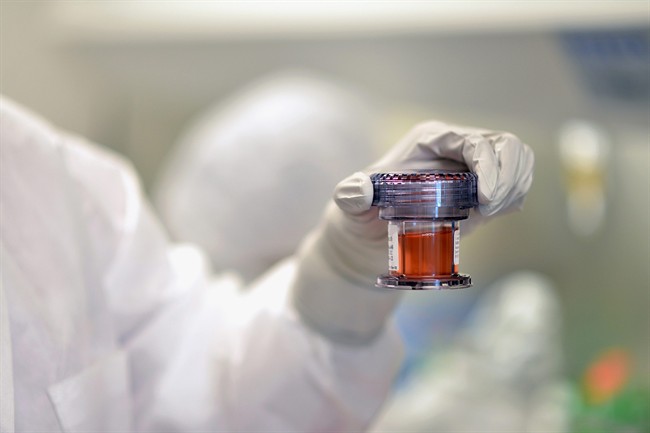MONTREAL – Finding a donor for a stem cell transplant is perhaps one of the most difficult things for a cancer patient.

This is because stem cells are one of the few things that patients cannot rely on their immediate family to donate, according to to Doctor Silvy Lachance, Director of the stem cell transplant program at Hôpital Maisonneuve-Rosemont.
“Of course, we first look within the family,” she said.
“But there is only 25 per cent chance of identifying a donor. If we don’t find a donor within the family, we try the international donor registry.”
According to the National Cancer Institute, bone marrow and peripheral blood stem cell transplantations are most commonly used to treat leukemia, lymphoma, neuroblastoma (a cancer that affects mostly infants and children) and multiple myeloma.
While they wait for a compatible donor, patients will be assigned a conditioning regiment, which may include radiation.
“This conditioning regiment will be followed by the infusion of stem cells that are compatible with the recipient,” said Lachance.
Yet, for most ethnic minorities or anyone of mixed-birth, the chances of finding an anonymous donor remain very difficult.
This is because while there are more than 16 million stem cell donors worldwide, nearly 75 per cent of them are Caucasian, giving them a 60 to 80 per cent chance of finding a donor.
- Posters promoting ‘Steal From Loblaws Day’ are circulating. How did we get here?
- As Canada’s tax deadline nears, what happens if you don’t file your return?
- Video shows Ontario police sharing Trudeau’s location with protester, investigation launched
- Solar eclipse eye damage: More than 160 cases reported in Ontario, Quebec
“When we look at the other ethnic communities, this chance is reduced to about 20 to 25 per cent if we are lucky and if we allow some disparity between the recipient and the donor.”
Over the years, the Canadian registries have worked hard to convince many ethnic minorities, including Asian, African and Spanish to sign up as donors – but the numbers are still small.
“Héma-Québec has been very proactive to try and convince ethnic minorities to donate and become a stem cell donor,” said Lachance.
Stem cells come from either a bone marrow transplant or a peripheral blood stem cell transplant to restore stem cells that were destroyed by high doses of chemotherapy and/or radiation therapy.
A bone marrow transplant includes putting the donor under some form of general anesthesia and drilling a hole in the pelvic bone to extract the bone marrow.
A peripheral blood stem cell is, according to Lachance, much less invasive but depending on the treatment may be less effective.
“It involves giving the donor a ‘growth factor,’ which will make the stem cells leave the bone and circulate within the blood,” she explained.
“At that time, we can collect the stem cells from the blood stream.”
Yet, both of these options require a compatible donor, someone who is considered a “ten on ten match.”
Lachance confirms there are two other possible ways a patient can receive a donation if they are unable to find a donor.
One of these options is called a cord blood transplant, which is taken from the umbilical cord of a fetus.
Parents have to register during pregnancy and the cord blood is extracted right after the baby is born.
“With cord blood, we can tolerate some disparities between the donor and the recipient. We don’t need a ten on ten match,” said Lachance.
The second possibility is called a haploidentical transplant, which is an option for about 70 per cent of patients who do not have a donor.
“We use a sibling who is at least one half compatible, then we manipulate the graph of the immune system” Lachance explained, though she points out that the less siblings a patient has, the harder it is.
Lachance points out the reason stem cell transplants are so crucial to recovery is because the procedure implements a brand new immune system in the patient’s body in order to completely destroy the cancer.
This is why doctors are working so hard to find alternatives to bone marrow for patients who cannot find a donor.
“The immune system will give the recipient the capacity to react to their own cancer cells. It’s like transplanting a defense system against the cancer.”




Comments